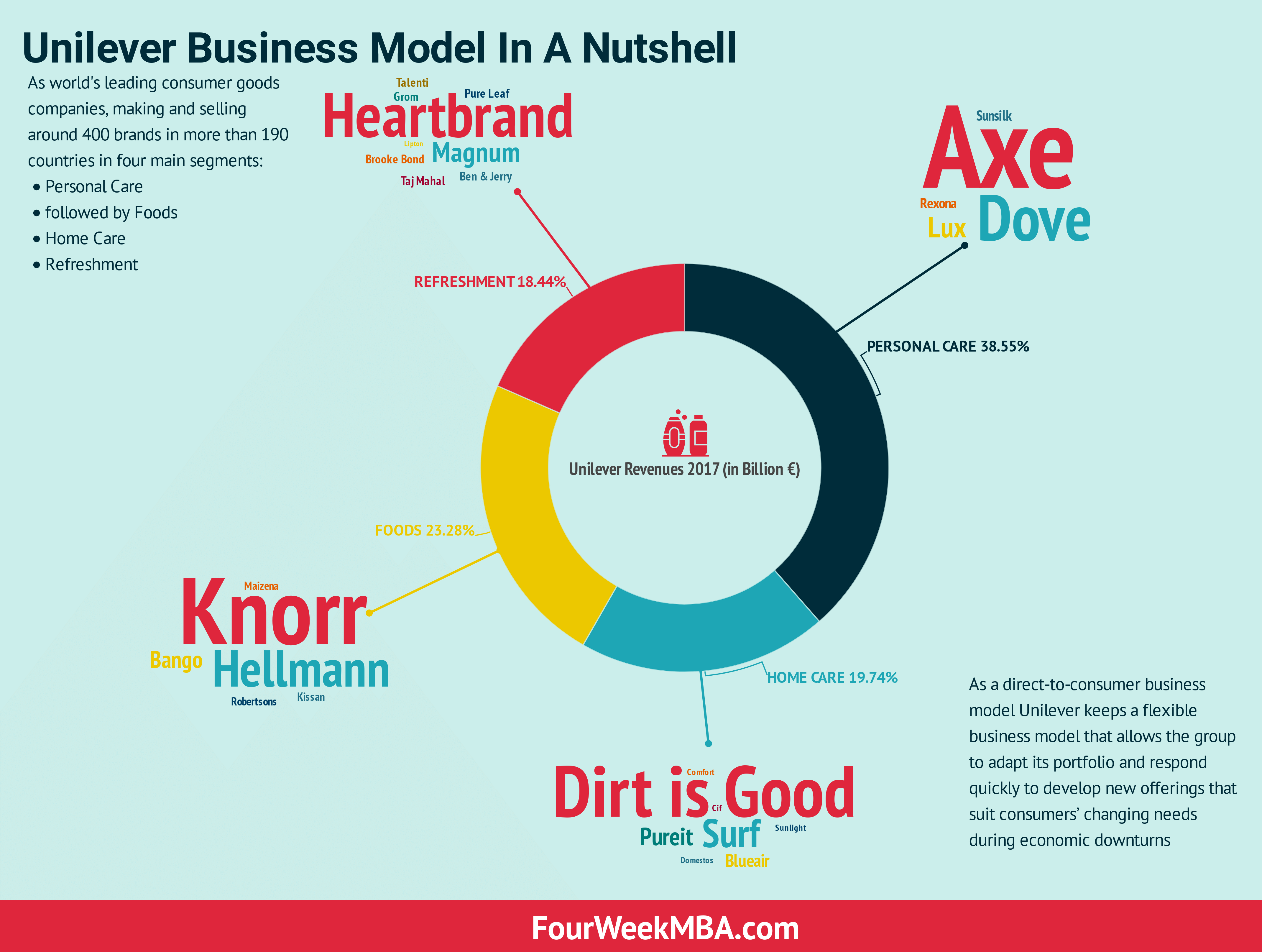| Not logged in : Login |
About: Unilever Direct-To-Consumers Business Model Goto Sponge NotDistinct Permalink

Unilever is the world's leading consumer goods companies, making and selling around 400 brands in more than 190 countries in 2017 - based on a direct-to-consumer business model. With over 53 billion euros in revenues that span across personal care, home care, foods and refreshment, Unilever is the second largest advertiser in the world. It's able to reach millions of consumers across the world thanks to its marketing campaigns. Unilever Purpose Unilever stated purpose is "to make a sustainable living to a commonplace. We believe this is the best way to deliver long-term sustainable growth." Unilever Operating segments During 2017, Unilever operated across four categories. The largest was Personal Care, followed by Foods, Home Care and Refreshment Source: Unilever annual report for 2017 Personal care is the largest segment in terms of revenues and also the most profitable regarding operating margins. It comprises brands like Axe, Dove, and Sunsilk. Unilever Direct-To-Consumer Business Model Based On A Global Value Chain Source: Unilever annual report for 2017 Unilever has been able to create a global value chain. This value chain is based on a direct-to-consumer business model, which requires a deep understanding of consumers and what brands they want to relate to. Therefore, Unilever leverages on massive marketing campaigns that aim at establishing a connection between consumers and those brands. Besides its claimed value chain, for sure the strength of Unilever is based on its ability to quickly adapt to economic scenarios, to purchase or push brands that can sell well during those periods. The critical ingredient is to structure the R&D for its product development, in a way that is coordinated with marketing activities. While the company gathers insights about consumers, used for product development. Indeed, Unilever spent over nine hundred million euros in R&D in 2017 alone. Unilever Massive Distribution Strategy In addition, the company can provide a proper distribution to its brands by working with thousands of suppliers across the world, with a massive supply chain that purchased over thirteen billion in ingredients and raw materials for its products and brands. Those materials are turned into finished products, based on consumer insights, and manufactured in more than three hundred factories in sixty-nine countries. The distribution and direct access to consumers via a network of more than four hundred warehouses and twenty-five million retail stores. Among direct-to-consumer channels, Unilever brands and products are served in: hypermarkets wholesalers and cash and carry small convenience stores other fast-growing channels such as e-commerce out-of-home and direct-to-consumer All those channels are critical to Unilever brands to make them properly available and displayed. A significant part of this distribution is also accompanied by massive spending in marketing campaigns, that in 2017 alone saw over seven billion euros in spending. The company also uses digital channels to create a target and more personalized campaigns based on consumer insights. And in doing so, our value chain cycle repeats itself. Source: Unilever annual report for 2017 To notice how among the most significant piece of the pie regarding spending the company leverages on distribution costs, brand, and marketing investments. That's how the value chain is created. Summary and conclusions Unilever leverages on a direct-to-consumer business model that in 2017 made over fifty billion in revenues. The key ingredients of this value chains are consumer insights that are used in their R&D strategy, that goes back to product development. Also, the company leverages on massive branding campaigns to make those brands on top of minds of its consumers. Reference for the financials: Unilever 2017 Annual Report Handpicked related content: What Is a Business Model? 30 Successful Types of Business Models You Need to Know What Is a Business Model Canvas? Business Model Canvas Explained The Power of Google Business Model in a Nutshell How Does Google Make Money? It’s Not Just Advertising! How Does PayPal Make Money? The PayPal Mafia Business Model Explained How Does WhatsApp Make Money? WhatsApp Business Model Explained How Does Facebook Make Money? Facebook Hidden Revenue Business Model Explained The Google of China: Baidu Business Model In A Nutshell How Does Twitter Make Money? Twitter Business Model In A Nutshell How Does DuckDuckGo Make Money? DuckDuckGo Business Model Explained How Amazon Makes Money: Amazon Business Model in a Nutshell How Does Netflix Make Money? Netflix Business Model Explained
| Attributes | Values |
|---|---|
| type | |
| label |
|
| label |
|
| sameAs | |
| Description |
|
| depiction | |
| name |
|
| url | |
| legalName |
|
| http://www.w3.org/2007/ont/link#uri |
Alternative Linked Data Documents: PivotViewer | iSPARQL | ODE Content Formats:
![[cxml]](/fct/images/cxml_doc.png)
![[csv]](/fct/images/csv_doc.png) RDF
RDF
![[text]](/fct/images/ntriples_doc.png)
![[turtle]](/fct/images/n3turtle_doc.png)
![[ld+json]](/fct/images/jsonld_doc.png)
![[rdf+json]](/fct/images/json_doc.png)
![[rdf+xml]](/fct/images/xml_doc.png) ODATA
ODATA
![[atom+xml]](/fct/images/atom_doc.png)
![[odata+json]](/fct/images/json_doc.png) Microdata
Microdata
![[microdata+json]](/fct/images/json_doc.png)
![[html]](/fct/images/html_doc.png) About
About


![[RDF Data]](/fct/images/sw-rdf-blue.png)
OpenLink Virtuoso version 08.03.3331 as of May 21 2024, on Linux (x86_64-generic-linux-glibc25), Single-Server Edition (7 GB total memory, 6 GB memory in use)
Data on this page belongs to its respective rights holders.
Virtuoso Faceted Browser Copyright © 2009-2024 OpenLink Software






